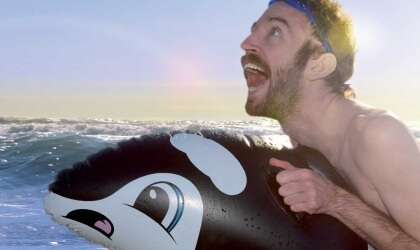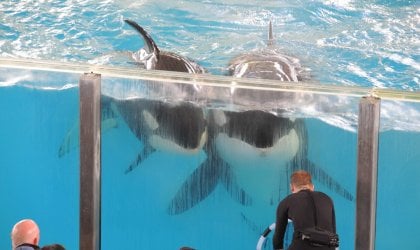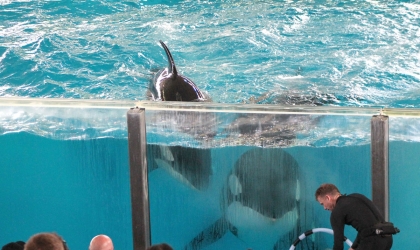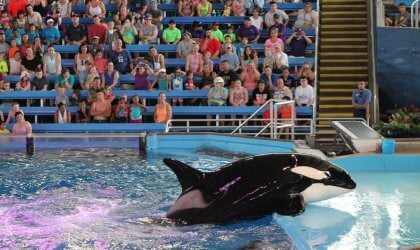SeaWorld trainer Dawn Brancheau began her Dine With Shamu show on February 24, 2010, just as she had many times before, but this particular show included a gruesome finale that left Brancheau’s body without her left arm or part of her scalp, among other injuries. Dawn Brancheau was declared dead shortly after the show, but still SeaWorld claims no responsibility for the vicious attack. So just how did one of SeaWorld’s most experienced and celebrated trainers end up crushed and drowned by the jaws of the marine park’s largest attraction?
“We don’t know for sure what motivated Tilikum. But there’s no doubt that he knew exactly what he was doing. He killed her.”
A Killer Whale Is Born
Former SeaWorld trainer Jeffrey Ventre blamed Tilikum for Brancheau’s death, but the truth begins with the wild orca’s capture near Iceland in 1983. At just 2 years old, he was torn from his mother and their ocean home and sent to the rundown marine park Sealand of the Pacific. Food was withheld from him as a training technique, and he endured attacks from the two dominant female orcas, whom he was forced to live with. After years of performing eight shows a day, seven days a week, Tilikum dragged Sealand trainer Keltie Byrne to the bottom of the pool, where he and the other orcas stripped her of all her clothing and left bite marks and bruises on her skin. It took nearly two hours to retrieve her body. Not long after Keltie’s death, Sealand closed its doors, and its orcas were purchased by SeaWorld.
“My understanding of the animal’s past was very limited. In fact, there had been 30 incidents between killer whales, and trainers prior to my being hired at the park. And I didn’t know about any of them until after I left SeaWorld. So I think that’s a serious mistake on SeaWorld’s part that they weren’t letting people know the history of all the animals.”
History Repeats Itself
As Dawn Brancheau lay next to Tilikum, petting him in just a few inches of water, she likely had no reason to suspect that she was about to be torn apart. According to one of SeaWorld’s own employees, the event was unpredictable and the orca gave no indication that he was about to grab her. Even if Brancheau had spotted signs that Tilikum might act aggressively, would SeaWorld’s star performer have done anything differently? Maybe not—trainers were expected to continue performances, regardless of any signs that an orca might act out.
 Dawn Brancheau - Riders on the Storm | Ed Schipul | CC BY-SA 2.0
Dawn Brancheau - Riders on the Storm | Ed Schipul | CC BY-SA 2.0Dawn Brancheau was one of SeaWorld’s star performers. She was cautious and always abided by the park’s “safety” guidelines when she was around the orcas. When her death was announced, former and current trainers were astonished that she had been the one killed.
In one case, trainers ended a show after an orca began to ignore signals, swim rapidly, and grab at one of the trainer’s arms. In response, SeaWorld’s vice president for animal training criticized their actions in a two-page document claiming that the show should not have been ended early because it brought unnecessary attention to the incident. He argued that the trainers should have used other resources before canceling the show, despite SeaWorld’s official position that trainers could end a show at any time if they felt uncomfortable.
Why were SeaWorld trainers being forced to interact so closely with these enormous wild mammals? This was precisely the issue at the center of the Occupational Safety and Health Administration’s (OSHA) investigation. The agency cited SeaWorld for multiple violations and demanded that the company stop putting trainers at risk by making them interact with orcas during shows.
The Truth Comes Out
SeaWorld finally gave up on appealing its violations, but not before OSHA presented damning evidence that seems to imply that SeaWorld may be responsible for its own trainer’s death. OSHA found that in the 20 years leading up to Brancheau’s death, the park generated 100 reports of aggression and precursors to aggression—including 12 incidents resulting in the injury or death of a trainer—and according to SeaWorld’s own corporate curator for zoological operations, there were times that the company didn’t document incidents at all, which can be evidenced by SeaWorld’s failure to generate an incident report for Dawn Brancheau’s death and for a third death that Tilikum may have previously been involved with.
SeaWorld had previously been warned of the potential danger of incorporating Tilikum into its marine park when obtaining a permit for the orca from the National Marine Fisheries Service (NMFS), long before Dawn Brancheau’s death. Upon applying for the permit, SeaWorld hadn’t even looked at the incident report about the Sealand trainer’s death, and after being urged by the NMFS to do so, SeaWorld attributed the previous attack to a design flaw at Sealand. SeaWorld reiterated multiple times while obtaining the license that its safety measures, training, and park facilities were superior to those of Sealand and would prevent such an event from occurring at its park.
Questions Remain
 "Shamu" (Tilikum) | Milan Boers | CC BY 2.0
"Shamu" (Tilikum) | Milan Boers | CC BY 2.0Tilikum, one of the largest orcas held captive at SeaWorld, was in captivity for over 30 years. His sperm was used to father over half the orcas at SeaWorld’s parks, even though he killed three humans.
Eleven years after the “accident,” there are still concerns about Dawn Brancheau’s last day as a SeaWorld trainer that have grave implications. Why did the marine park wait for 27 minutes to call for paramedics after Tilikum pulled Brancheau into the water? Was the park using this time to remove witnesses whose accounts didn’t match the story that SeaWorld was trying to create to make it seem as if her ponytail had triggered Tilikum’s reaction? Perhaps most importantly, why did SeaWorld’s then-owner try to blame his own orca trainer for her death—even after the OSHA investigation uncovered that the same safety measures and recall signals that had failed to prevent Dawn Brancheau’s death had been failing for years? And why did SeaWorld continue to rely on those failed measures?
“Let’s face it, in these types of incidents, I don’t recall any whale responding to any hand slap, food bucket, or any other distraction we tried to implement.”
The evidence in the judge’s decision seems to indicate that SeaWorld tried to downplay the risks and dangers that its trainers would encounter while working with captive orcas and to cover up its own failures in the incident that led to Dawn Brancheau’s death. SeaWorld wasn’t even willing to put the life of its own star trainer before profit, so why should anyone trust that it would ever put the well-being of its captive animals first?
Learn more about cruelty at SeaWorld on The PETA Podcast:
Listen to more episodes on iTunes, Stitcher, and Spotify! Subscribe for new episodes.
To help all animals held captive by SeaWorld, please never buy a ticket, visit the parks, or support SeaWorld in any other way, and urge the marine park to stop forcibly breeding other dolphins!




